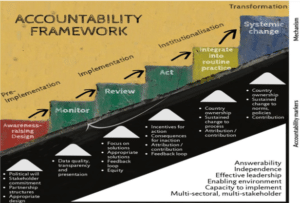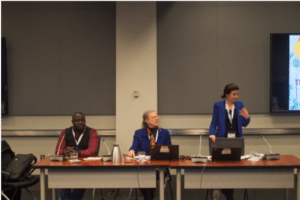Monitoring and Measuring Social Accountability: What does inclusiveness look like?
Allison Annette Foster, Thumbiko Msiska, and Marleen Vellekoop. November 20, 2019
Napoleão Bernardes, popular two-time mayor of Blumenau Brazil, opened the annual GPSA Forum 2019 this week. Speaking to a full house of global participants at the World Bank meeting hall, Mr. Bernades challenged social accountability advocates to see Social accountability as part of good governance. Social Accountability, he proposed, brings empathy into policy and creates the space for governments and civil society to meet around the same table. This process enhances transparency and accountability, which enables governments improve the quality and accessibility of public services.
Our group of practitioners and researchers are a part of a community of practice around SA that have been working together to achieve just that: an institutionalized system of social accountability that raises excluded voices to be heard by decision makers and to influence policies that improve services and advance equity.
Our team of researchers[1] and development practitioners explore how social accountability actually works. We are asking questions that will be important for sustainability, self-reliance and transparency:
- What does accountability look like in a sustainable context?
- How we will monitor progress, recognize gaps and opportunities for improvement, ensure inclusiveness, and measure success?
- What kind of indicators can capture or reflect and track inclusiveness, meaningful participation, and power shifts?
In an interactive session on the first day of the Forum[2], our team shared our recent work to increase inclusion in health system decisions and health service improvements. Mr. Thumbiko Msiska of CARE|Malawi presented a case study of his experience in Malawi introducing social accountability through various approaches and highlighted the successes and challenges faced as Malawi partners aim to scale SA practices.
Marleen Vellekoop of Options and Allison Annette Foster of WI-HER, LLC shared recent works  from Ligia Paina et al[3] and Adriana Martin-Hilber et al[4], and demonstrated an accountability framework that has been the basis of a monitoring tool that is currently being used to integrate monitoring into the accountability process. That framework is also being adapted to help governments assess their own state or national programs for effectiveness and inclusiveness.
from Ligia Paina et al[3] and Adriana Martin-Hilber et al[4], and demonstrated an accountability framework that has been the basis of a monitoring tool that is currently being used to integrate monitoring into the accountability process. That framework is also being adapted to help governments assess their own state or national programs for effectiveness and inclusiveness.
The session brought about a rich discussion with participants from DRC, Sierra Leone, Ghana, Malawi, USA, Cambodia, Indonesia, Senegal, Cameroon, Dominican Republic and other countries.
All session participants agreed that monitoring progress in social accountability is difficult because accountability initiatives are often abstract and complex, existing of dynamic interactions between social actors. Nevertheless, monitoring and evaluating efforts to increase accountability are essential to better understand the effectiveness of accountability interventions. In particular, discussions among representatives called for the following to improve inclusiveness in governance:
- As social accountability programs are institutionalized, there needs to be a sustained practice of bringing excluded voices to the center of decision making.
- More learning is needed on how the inclusion of marginalized groups is achieved.
- Although inclusion is the focus of social accountability interventions, our M&E practices are not always inclusive. Complex M&E tools and technologies can sometimes present barriers to SA intervention beneficiaries so that they are not able to participate in the M&E process.
- Researchers often keep communities at the periphery of their efforts rather than giving them a role in the research process. Instead, those who are part of or benefit from social accountability interventions (e.g. communities) should be at the center of monitoring and evaluation frameworks, giving them a central role in the M&E process.
- There is need to understand the process of representation. Community voices are often channeled through filters of (ie. Community members work though community committees, which then move to district forums, provincial platforms, national working groups). It is important to make sure that representatives convey the voices of communities through the right processes and represent all community members with equity, bringing traditionally excluded voices to the center of decision making.
- There is a need to better understand how we measure or track power dynamics and how these dynamics influence social accountability; and in particular, how power keeps out or includes underrepresented voices into meaningful participation.
The discussion revealed the shared struggle to find ways to better monitor social accountability so  that we can track the complex nuances that are critical to inclusiveness. All acknowledged that monitoring social accountability and defining indicators to make that possible is a daunting task, but imperative in achieving lasting social accountability mechanisms that ensure systems that respond to community needs, reflects the most marginalized, and informs necessary adjustments to continuously recognize power shifts and include those outside those circles of influence.
that we can track the complex nuances that are critical to inclusiveness. All acknowledged that monitoring social accountability and defining indicators to make that possible is a daunting task, but imperative in achieving lasting social accountability mechanisms that ensure systems that respond to community needs, reflects the most marginalized, and informs necessary adjustments to continuously recognize power shifts and include those outside those circles of influence.
Authors would like to recognize the World Bank Group for the support and resources that made it possible for us to present, the CORE Group Systems for Health Working Group for providing a platform from which a community of practice functions, and contributors to the session who were unable to attend (and are not previously mentioned): Kristen Mallory of Children International; Eric Sarriot of Save the Children; Beth Outterson of CORE Group; Julie Saracin and Jessica Bishai of Johns Hopkins University; and Sara Bandali and Patricia Doherty of Options, and Andrea Nove of Novametrics
[1] WI-HER, Children International, Johns Hopkins University, Swiss Tropical Health Institute, Options, Save the Children, and CARE|Malawi
[2] Enhancing Inclusiveness: Reflections, Challenges, and Opportunities in Measuring and Evaluating Social Accountability Practice in Health
[3] Ligia Paina, Julie Saracino ,Jessica Bishai, and Eric Sarriot,. M&E of Evolving Social Accountability Efforts in Health: A Literature Synthesis. Core Group (2019). Available online: https://coregroup.org/wp-content/uploads/2019/05/ME-of-Evolving-SA-Efforts-in-Health-2019-Final.pdf
[4] Adriane Martin-Hilber, Sara Bandali, Patricia Doherty, Andrea Nove. The Development of a New Accountability Framework and Tool for Global Health Initiatives. Options (2019)